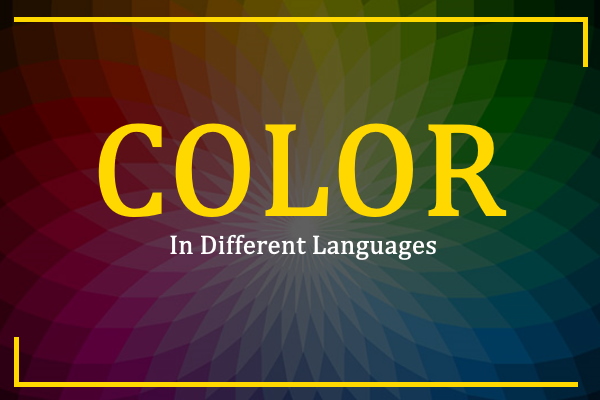Table of Contents
Color in Different Languages: Color is a light property seen by people. Color is detected by special receptor cells “cones”. Light a combination of all the colors of rainbow. Color is characteristic of seeing and differentiating between different light shades. Colors are formed on through variations in visible wavelength that passes through them.
Color in All Languages
Translation of word Color in almost 100+ different languages of the world.
| Different Languages | Word Color |
|---|---|
| Albanian | ngjyrë |
| Basque | color |
| Belarusian | колер |
| Bosnian | boja |
| Bulgarian | цвят |
| Catalan | color |
| Croatian | boja |
| Czech | barva |
| Danish | farve |
| Dutch | kleur |
| Estonian | värv |
| Finnish | väri |
| French | Couleur |
| Galician | cor |
| German | Farbe |
| Greek | χρώμα (chróma) |
| Hungarian | szín |
| Icelandic | Litur |
| Irish | dath |
| Italian | colore |
| Latvian | krāsa |
| Lithuanian | spalva |
| Macedonian | боја |
| Maltese | kulur |
| Norwegian | farge |
| Polish | kolor |
| Portuguese | cor |
| Romanian | culoare |
| Russian | цвет (tsvet) |
| Serbian | боја (boja) |
| Slovak | farba |
| Slovenian | barva |
| Spanish | color |
| Swedish | Färg |
| Ukrainian | колір (kolir) |
| Welsh | lliw |
| Yiddish | פאַרב |
| Armenian | գույն |
| Azerbaijani | rəng |
| Bengali | রঙ |
| Chinese Simplified | 颜色 (Yánsè) |
| Chinese Traditional | 顏色 (Yánsè) |
| Georgian | ფერი |
| Gujarati | રંગ |
| Hindi | रंग |
| Hmong | xim |
| Japanese | 色 |
| Kannada | ಬಣ್ಣದ |
| Kazakh | түс |
| Khmer | ប៍ន |
| Korean | 색깔 (saegkkal) |
| Lao | ສີ |
| Malayalam | നിറം |
| Marathi | रंग |
| Mongolian | өнгө |
| Myanmar (Burmese) | အရောင် |
| Nepali | रंग |
| Sinhala | වර්ණ |
| Tajik | ранг |
| Tamil | நிறம் |
| Telugu | రంగు |
| Thai | สี |
| Turkish | renk |
| Urdu | رنگ |
| Uzbek | rang |
| Vietnamese | màu |
| Arabic | اللون (allawn) |
| Hebrew | צֶבַע |
| Persian | رنگ |
| Afrikaans | kleur |
| Chichewa | mtundu |
| Hausa | launi |
| Igbo | agba |
| Sesotho | mala |
| Somali | midabka |
| Swahili | rangi |
| Yoruba | awọ |
| Zulu | umbala |
| Cebuano | kolor |
| Filipino | kulay |
| Indonesian | warna |
| Javanese | werna |
| Malagasy | loko |
| Malay | warna |
| Maori | tae |
| Esperanto | koloro |
| Haitian Creole | koulè |
| Latin | color |
Color in European Languages
Translation of word Color in almost 42 European languages.
| Different Languages | Word Color |
|---|---|
| Albanian | ngjyrë |
| Basque | color |
| Belarusian | колер |
| Bosnian | boja |
| Bulgarian | цвят |
| Catalan | color |
| Corsican | culore |
| Croatian | boja |
| Czech | barva |
| Danish | farve |
| Dutch | kleur |
| Estonian | värv |
| Finnish | väri- |
| French | Couleur |
| Frisian | kleur |
| Galician | cor |
| German | Farbe |
| Greek | χρώμα [chróma] |
| Hungarian | szín |
| Icelandic | Litur |
| Irish | dath |
| Italian | colore |
| Latvian | krāsa |
| Lithuanian | spalva |
| Luxembourgish | Faarf |
| Macedonian | боја |
| Maltese | kulur |
| Norwegian | farge |
| Polish | kolor |
| Portuguese | cor |
| Romanian | culoare |
| Russian | цвет [tsvet] |
| Scots Gaelic | dath |
| Serbian | боја [boja] |
| Slovak | farba |
| Slovenian | barva |
| Spanish | color |
| Swedish | Färg |
| Tatar | төс |
| Ukrainian | колір [kolir] |
| Welsh | lliw |
| Yiddish | קאָליר |
Color in Asian Languages
Translation of word Color in almost 36 Asian languages.
| Different Languages | Word Color |
|---|---|
| Armenian | գույն |
| Azerbaijani | rəng |
| Bengali | রঙ |
| Chinese Simplified | 颜色 [yánsè] |
| Chinese Traditional | 顏色 [yánsè] |
| Georgian | ფერი |
| Gujarati | રંગ |
| Hindi | रंग |
| Hmong | xim |
| Japanese | 色 |
| Kannada | ಬಣ್ಣದ |
| Kazakh | түс |
| Khmer | ប៍ន |
| Korean | 색깔 [saegkkal] |
| Kyrgyz | түс |
| Lao | ສີ |
| Malayalam | നിറം [nirram] |
| Marathi | रंग |
| Mongolian | өнгө |
| Myanmar (Burmese) | အရောင် |
| Nepali | रंग |
| Odia | ରଙ୍ଗ |
| Pashto | رنګ |
| Punjabi | ਰੰਗ |
| Sindhi | رنگ |
| Sinhala | වර්ණ |
| Tajik | ранг |
| Tamil | நிறம் |
| Telugu | రంగు |
| Thai | สี |
| Turkish | renk |
| Turkmen | reňk |
| Urdu | رنگ |
| Uyghur | رەڭ |
| Uzbek | rang |
| Vietnamese | màu |
Color in Middle East Languages
Translation of word Color in 4 middle eastern languages.
| Different Languages | Word Color |
|---|---|
| Arabic | اللون [allawn] |
| Hebrew | צֶבַע |
| Kurdish (Kurmanji) | reng |
| Persian | رنگ |
Color in African Languages
Translation of word Color in almost 13 African languages.
| Different Languages | Word Color |
|---|---|
| Afrikaans | kleur |
| Amharic | ቀለም |
| Chichewa | mtundu |
| Hausa | launi |
| Igbo | agba |
| Kinyarwanda | ibara |
| Sesotho | mala |
| Shona | ruvara |
| Somali | midabka |
| Swahili | rangi |
| Xhosa | umbala |
| Yoruba | awọ |
| Zulu | umbala |
Color in Austronesian Languages
Translation of word Color in almost 10 Austronesian languages.
| Different Languages | Word Color |
|---|---|
| Cebuano | kolor |
| Filipino | kulay |
| Hawaiian | kala |
| Indonesian | warna |
| Javanese | werna |
| Malagasy | loko |
| Malay | warna |
| Maori | tae |
| Samoan | lanu |
| Sundanese | warna |
Color in Other Foreign Languages
| Different Languages | Word Color |
|---|---|
| Esperanto | koloro |
| Haitian Creole | koulè |
| Latin | color |
Video Translation of Color in 10 Other Languages
Coming Soon…
More Information about Color
When a certain wavelength of light strikes through it, the color is formed. Color formation depends of the physical properties of an object such as surface, reflection, absorption etc.
The most common colors include red, blue, orange, white, green, yellow, orange etc. Primary colors are mixed with other colors to form a new shade.
Such as by mixing red and yellow we can get a shade of orange. Red yellow and blue are the three primary colors. All other color’s formation is done by mixing these.
Another factor to differentiate among colors is the presence of sufficient light. Color can not be easily distinguished in a dim light.
Light of a critical intensity is required. Also, quality of colors depends on the nature of material and how it interacts with light. However, by its color, saturation, and brightness.
The color can be precisely specified – these three characteristics are enough to distinguish between it and other perceived colors.
All the rainbow colors mixed with each other are in the sun’s rays. The blend is known as white light. It seems clear as white light hits a white pencil or a marker barrel it remains white because it doesn’t lose some color and retains the same hue.
A black pencil or marker absorbs all colors, so it looks black to us. Although musicians consider black as a color, scientists don’t believe black is the absence of color.
In some people their cones are not developed, and they cannot differentiate between colors or are completely color blind which means they see no color.
Colors have cultural significance also. White defines purity and blue reflects heaven. Today, purple is associated with evil in japan, but same is confined to color blue in Asia.
There is a general instinct about colors in different culture and religion according to the mindset of people. This does not happen to be true always.

Arslan Hussain, founder of The Different Languages, is an experienced translator passionate about languages and cultures. Through his website, he shares his knowledge and love for different languages, making learning accessible and enjoyable.

